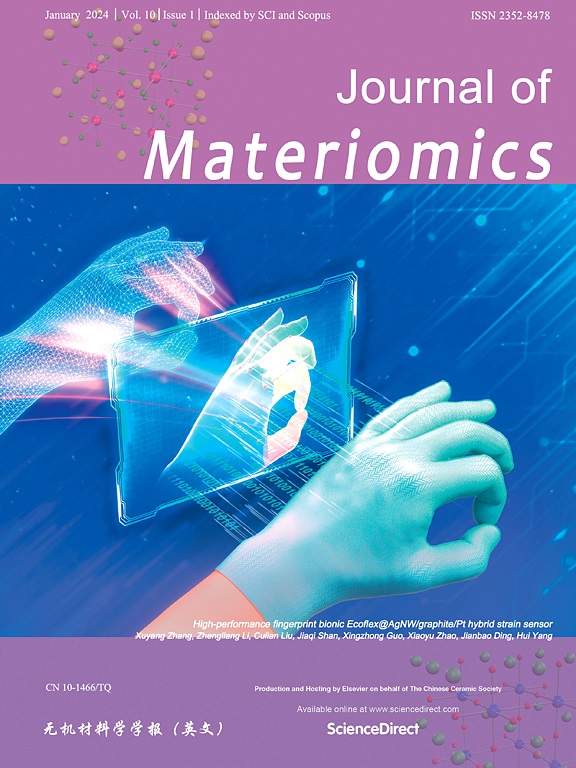通过协同优化策略,实现了钨青铜陶瓷优异的储能性能
IF 8.4
1区 材料科学
Q1 CHEMISTRY, PHYSICAL
引用次数: 0
摘要
采用固相法制备了一系列钨青铜(Sr2-xBixAg0.2Na0.8) (Nb4.8-xZrxSb0.2)O15化合物,系统研究了在A/ b位共掺杂Bi3+/Zr4+离子对结构、弛豫特性和储能性能的影响。结构与弛豫行为的关系主要有三点:(1)随着共掺杂Bi3+/Zr4+离子量的增加,室温下晶体结构由正交Bbm2演变为四方准电P4/mbm对称;(2)通过调整Tm−TB的温度区域(Tm为介电最高温度,TB为Burns温度),实现了室温下弛豫特性的增强,这可能是由于P4bm对称性的正交畸变和微畴的出现引起的局部结构调制不相称;(3) Bi3+和Zr4+的共引入还可以抑制晶粒尺寸,增加电阻率和带隙,从而提高击穿强度。最后,在389 kV/cm下,BZ0.05陶瓷获得了优异的可回收储能密度(3.61 J/cm3)和超高的能量效率(90%)。此外,通过充放电性能测量,在220 kV/cm下实现了出色的功率密度(158.98 MW/cm3)和1422.29 a /cm2的电流密度。优异的储能性能使环境友好的BZ0.05样品在大功率电容器中显示出巨大的应用潜力。本文章由计算机程序翻译,如有差异,请以英文原文为准。

Excellent energy-storage performance realized in SANNS-based tungsten bronze ceramics via synergistic optimization strategy
A series of tungsten bronze (Sr2–xBixAg0.2Na0.8) (Nb4.8–xZrxSb0.2)O15 compounds were fabricated by solid-state method to systematically study the impacts of co-doping Bi3+/Zr4+ ions in A/B-sites on the structures, relaxor characteristics, and energy-storage performances. The relationship between structures and relaxor behaviors are summarized as three main points: (1) with increasing the amount of co-doping Bi3+/Zr4+ ions, the crystal structure evolved from an orthorhombic Bbm2 to a tetragonal paraelectric P4/mbm symmetry at room temperature; (2) enhancing relaxor characteristics at room temperature was achieved by tailoring the temperature region of Tm−TB (Tm is the dielectric maximum temperature, TB is the Burns temperature), which could be attributed to the incommensurate local structure modulations associated with the orthogonal distortion of P4bm symmetry and the appearance of microdomains; (3) The co-introduction of Bi3+ and Zr4+ could also played an important role in inhibiting the grain sizes, increasing resistivity and band-gap to enhance the breakdown strength. Finally, a superior recoverable energy-storage density (3.61 J/cm3) and an ultrahigh energy efficiency (90%) were obtained simultaneously at 389 kV/cm in BZ0.05 ceramics. Moreover, an outstanding power density (158.98 MW/cm3) together with a current density of 1422.29 A/cm2 was realized at 220 kV/cm from the charging−discharging performance measurements. The excellent energy-storage performance (ESPs) make the environmentally friendly BZ0.05 samples show enormous potential in high-power capacitor applications.
求助全文
通过发布文献求助,成功后即可免费获取论文全文。
去求助
来源期刊

Journal of Materiomics
Materials Science-Metals and Alloys
CiteScore
14.30
自引率
6.40%
发文量
331
审稿时长
37 days
期刊介绍:
The Journal of Materiomics is a peer-reviewed open-access journal that aims to serve as a forum for the continuous dissemination of research within the field of materials science. It particularly emphasizes systematic studies on the relationships between composition, processing, structure, property, and performance of advanced materials. The journal is supported by the Chinese Ceramic Society and is indexed in SCIE and Scopus. It is commonly referred to as J Materiomics.
 求助内容:
求助内容: 应助结果提醒方式:
应助结果提醒方式:


